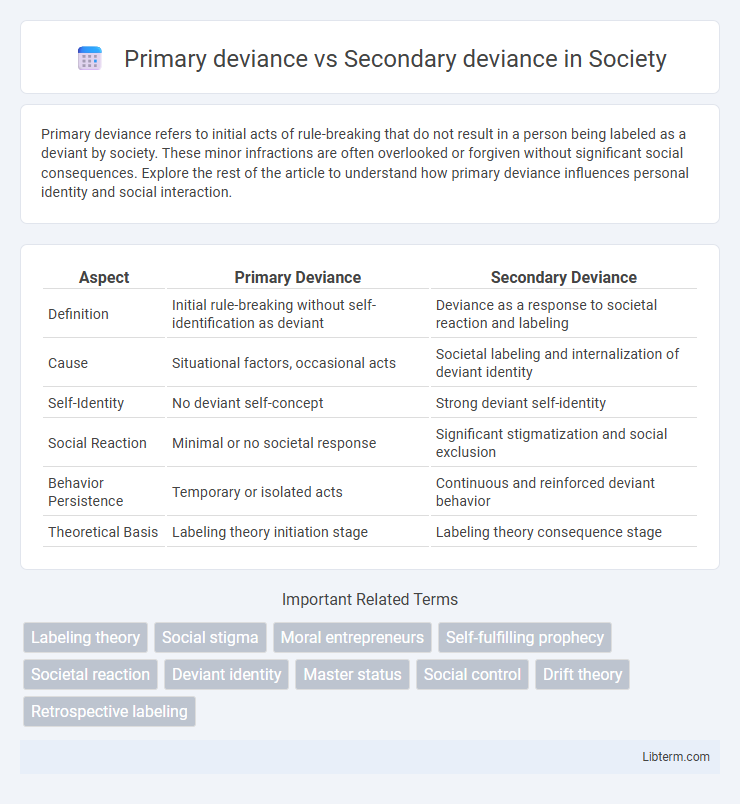Primary deviance refers to initial acts of rule-breaking that do not result in a person being labeled as a deviant by society. These minor infractions are often overlooked or forgiven without significant social consequences. Explore the rest of the article to understand how primary deviance influences personal identity and social interaction.
Table of Comparison
| Aspect | Primary Deviance | Secondary Deviance |
|---|---|---|
| Definition | Initial rule-breaking without self-identification as deviant | Deviance as a response to societal reaction and labeling |
| Cause | Situational factors, occasional acts | Societal labeling and internalization of deviant identity |
| Self-Identity | No deviant self-concept | Strong deviant self-identity |
| Social Reaction | Minimal or no societal response | Significant stigmatization and social exclusion |
| Behavior Persistence | Temporary or isolated acts | Continuous and reinforced deviant behavior |
| Theoretical Basis | Labeling theory initiation stage | Labeling theory consequence stage |
Introduction to Deviance
Primary deviance involves initial acts of rule-breaking that do not affect an individual's self-identity or social status, often occurring without societal labeling. Secondary deviance arises when a person internalizes deviant labels, leading to a deviant identity and continued rule-breaking behavior. Understanding primary and secondary deviance is crucial in the study of deviance, highlighting the impact of societal reaction and labeling on criminal behavior.
Defining Primary Deviance
Primary deviance refers to initial acts of rule-breaking or norm violations that do not result in the individual being labeled as a deviant. These acts are often minor, sporadic, and situational, allowing the individual to maintain a conventional identity without internalizing a deviant self-concept. Understanding primary deviance is essential for distinguishing between temporary deviant behavior and the more entrenched patterns seen in secondary deviance.
Understanding Secondary Deviance
Secondary deviance occurs when an individual internalizes a deviant identity after being labeled by society, leading to continued or intensified deviant behavior. This concept, developed by sociologist Edwin Lemert, highlights the role of societal reaction in transforming initial primary deviance into a self-fulfilling prophecy. Understanding secondary deviance is critical for analyzing how deviant labels influence identity and social dynamics over time.
Key Differences Between Primary and Secondary Deviance
Primary deviance refers to minor, initial acts of rule-breaking that do not affect an individual's self-identity or social status, often viewed as isolated incidents. Secondary deviance occurs when an individual accepts the deviant label imposed by society, leading to a change in self-concept and continued deviant behavior. The key differences include the impact on identity, where primary deviance is a temporary action without stigma, and secondary deviance involves internalization of the deviant role, resulting in a deviant career or lifestyle.
Theoretical Foundations: Labeling Theory
Primary deviance refers to initial, minor acts of rule-breaking that do not impact an individual's self-identity or social status. Secondary deviance occurs when an individual internalizes a deviant label, leading to continued rule-breaking behavior and a redefined identity. Labeling theory, developed by sociologists such as Howard Becker, provides the theoretical foundation by emphasizing how societal reactions and labels contribute to the transition from primary to secondary deviance.
Real-World Examples of Primary Deviance
Primary deviance involves initial acts of rule-breaking that do not affect an individual's self-identity or social status, such as a teenager shoplifting once without facing harsh social labeling. Real-world examples include minor traffic violations or first-time drug use, where the individual is unlikely to be stigmatized or ostracized. These acts often go unnoticed or are seen as isolated incidents, preventing the escalation to secondary deviance where deviant identity and societal reaction become intertwined.
Real-World Examples of Secondary Deviance
Secondary deviance occurs when an individual internalizes a deviant label and continues to engage in deviant behavior, often reinforcing a deviant identity. For example, a teenager initially caught shoplifting (primary deviance) may be labeled as a delinquent and, as a result of social stigma and exclusion, increasingly involve themselves in criminal activities like gang membership or drug use. This progression demonstrates how social reactions and labeling contribute to the persistence and escalation of deviant behavior in real-world scenarios.
Social Reactions and Their Impact
Social reactions play a crucial role in differentiating primary deviance from secondary deviance, as primary deviance involves minor norm violations often ignored or tolerated by society, whereas secondary deviance emerges when individuals internalize the deviant label imposed by social responses. Stigmatization and labeling by peers, authorities, or institutions reinforce deviant identity, intensifying the likelihood of continued deviant behavior. This dynamic illustrates how societal reactions not only reflect norms but actively shape individual self-concepts and deviance trajectories.
Consequences of Secondary Deviance
Secondary deviance results in significant social consequences such as stigma and a reinforced deviant identity, often leading to social exclusion and limited access to conventional opportunities. This process can entrench individuals in deviant behavior due to societal reactions, increasing the likelihood of recidivism and persistent deviance as per labeling theory. The escalation from primary to secondary deviance highlights how societal response shapes long-term behavioral patterns and personal identity.
Implications for Policy and Society
Understanding primary deviance as initial minor rule-breaking and secondary deviance as the subsequent lifestyle adoption due to societal reaction highlights the need for policies that prevent stigmatization and labeling. Law enforcement and rehabilitation programs should focus on early intervention and reintegration to reduce the risk of deviant identity formation. Societal attitudes that avoid harsh labeling can decrease recidivism and promote social cohesion by supporting individuals in resisting deviant self-concepts.
Primary deviance Infographic

 libterm.com
libterm.com